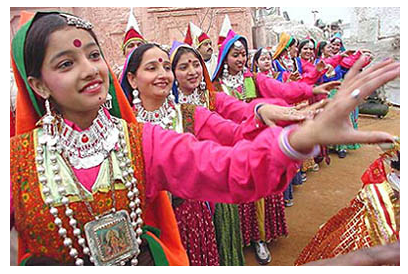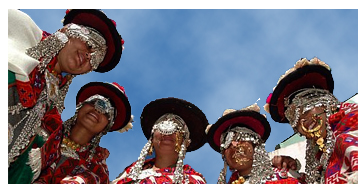DANCE FORMS OF HIMACHAL PRADESH
Contents
· Introduction
· The Mala (garland) Dance
· The Demon (Rakshasa) Dance or Chhambha
· The Dalshone and Cholamba Dances
· The Nagas Kayang
· Jataru Kayang
· The Shan and Shabu Dances
· Nuala
· Keekali and Bhangra
· The Jhoori, Gi, Swang Tegi and Rasa Dances
· Khaydayat and Lamba Dances
· The Lahadi and Ghooghati Dances
· The Dand Ras and Dangi Dances
· Music
· Musical Instruments
· Percussion Instruments
· Wind Instruments
· String Instruments and Cymbals
Introduction
Himachal Pradesh is also known as the land of dances. The dance forms of Himachal Pradesh are varied and very complicated. It is also regarded as an inseparable part of the life of the tribals. The dances are considered to be a break from the monotony of life. The various dance forms of Himachal Pradesh are briefly described as follows:
The Mala (garland) Dance
Also known as the Kayang Mala dance, the Mala or garland dance is very popular in Himachal Pradesh. The dancers, after consuming Chhang or rice brew, weave their arms together in circle to form a criss-cross pattern resembling an intricately woven garland.
The Demon (Rakshasa) Dance or Chhambha
The Kinnaur dance replicates the story of the demonic forces being chased away by the good forces, after trying to destroy the crops. This dance is reminiscent of the prehistoric period.
The Chhambha dance is somewhat similar to the Punjabi dance of Bhangra. The dancers wear the masks of demon and are led by the leader of the team, known as Ghure. Both the men and women dance together during the performance. This dance is especially performed during the Bishu and Chaitol festivals.
The Dalshone and Cholamba Dances
The Dalshone or the Cholamba dances are very popular in the Ropa valley of Himachal Pradesh. The dancers look like coiled serpents during the performance. The Cholamba dance is performed when a tiger is killed. The dead tiger’s skin is stuffed up and gold ornaments are put around the nose. The carcass of the animal is rotated in the air and the people dance around it.
The Nagas Kayang
The Nagas Kayang replicates the movement of a snake in the dance from. The Herki Kayang is similar in performance and is often danced to the tune of a romantic song. The Shuna Kayan is also similar, but combines both fast and slow tempo in the movements. Daily lives of the villagers are depicted in the songs accompanying the dances.
Jataru Kayang
The Jataru Kayang is usually performed on all important festivals. The Ghure or the leader deposits a small fee in the temple, to use the Chamar for the dance performance. The Chamar ultimately leads to a lot of resentment amongst the dancers and ultimately results in fighting.
The Shan and Shabu Dances
The Shan and Shabu dances are the two popular dances of the people of the Lahaul valley. The dances are performed at the Buddhist Gomphas in memory of Lord Buddha.
Shans are the prayers dedicated to Lord Buddha. The dances performed to accompany these prayers are known as the Shan dance. It is performed by the local tribals after the harvesting of the crops. The musical instruments accompanying the performance are drums, shehnai and violin.
The Shabu dance form is similar in manner and is performed to portray the feelings and beliefs of the local people.
Nuala
The Nuala is mysterious folk dance dedicated to Lord Shiva. In this dance form, a garland is placed on the pedestal of Lord Shiva and many dances and dramas are performed around it. Men and women possessed by evil spirits are brought here to be warded off those forces. The Chela, the chief devotee of Lord Shiva in the area, predicts the future and prophesys about the world.
Keekali and Bhangra
The Keekali or Kikli dance is very popular among young girls. In this dance, the girls form groups of twos and hold onto the hands of the other in a criss-crossed manner. They rotate fast on their toes, by holding onto the hands of the other dancer.
Originating from neighbouring Punjab, Bhangra is very popular in the Kangra, Una and Hamirpur areas of Himachal Pradesh.
The Jhoori, Gi, Swang Tegi and Rasa Dances
These dance forms are very popular, especially in and around the Sirmaur region.
Jhoori is performed in open spaces and is danced to the rhythm of questions and answers delivered in musical tones. Each line of the song ends with the chanting of Hoo Hoo.
Gi dance is performed in the three varieties of intricate beats. The singers stand in a circular pattern, while the dancers stand at the centre of the circle with their arms outstretched.
Also known as Thadair, the Dhadair dance is based upon the themes of local legends. It is performed to the Rudra Tal. During the performance, the dancers carry aloft different weapons such as sticks, bows, arrows, knives, etc. and charge towards their imaginative adversaries.
The Rasa dance symbolizes the unity of the people. During the performance, the dancers step back and forth, and leap up and down alternatively.
The Swang Tegi dance is performed by wearing tiger masks. During the performance, the gesture of animals are copied and performed.
The Droondu and Dharvedi dances are performed during the Jagaras and Shant. They depict the scenes from the battlefields, religious episodes and history.
Khaydayat and Lamba Dances
During the performance of the Khaydayat dance, the dancers hold a sword in one of their hands and a scabbard in the other. The marvellous sword-play exhibited by the dancers during the performance is a sight to behold. The dance takes a vigorous form when the tempo of the music increases.
During the performance of the Lamba dance, the dancer alternates the movement of their feet, by stepping back and forth, in a very fast and rhythmic manner. They also clap their hands along with the movement of their feet.
The Lahadi and Ghooghati Dances
Lahadi is a very popular dance form of the hill communities of Himachal Pradesh. It is performed exclusively by women and no musical instruments accompany the performance. Two groups of women stand face to face with each other. One of the groups starts singing and bends their waists alternately to retreat, which is followed by the other group in a similar manner. The dance performance lasts for a long time.
The Ghoogati dance of Himachal Pradesh places a lot of emphasis on the physical movements of the dancers. All the dancers stand in a single line and they place their hands on the shoulders of the performer in front of them. The first three or four dancers sing and the rest repeat the lines. The dancers sway their bodies forward, backward, sideward, and backward and are able to create beautiful choreographic compositions.
The Dand Ras and Dangi Dances
Dangi dance form is very popular in the Chamba area of Himachal Pradesh and is performed on the occasions of weddings, festivals and Jatra of the Gaddi women. The dancers arrange themselves in a semi-circular pattern and the dance is accompanied with the singing of love ballads of Bhukhu and Sunni. The dancers join their hands and perform their dance, and they finally leave the circular pattern in a very graceful manner.
The Danda Ras is performed to the complex rhythms of the Lahauli and Dhamal. The dancers usually wear Churidar Pyjamas and Chola Dora.
Music
The folk music is a very significant aspect of the lives of the poor people living in the remote regions of Himachal Pradesh. The most popular forms of folk music in Haryana are as follows:
- Jhoori or Sirmaur
- Laman of Kulu
- Mohna of Bilaspur
- Junju Sukrat Bhunkh
- Roopshu songs of the Chamba valley
- Laman
- Mohana
- Chhinj
- Gangi
- Tappe
- Jhoori
- Dholru
- Suhaag
- Alhaini
- Soohadiyan
- Karak
- Pakkahad
- Losi
- Bare-Haren
Musical Instruments
The different musical instruments used to accompany the folk music are as follows:
Drums
The different varieties of drums used in Himachal Pradesh are as follows:
- Dammama
- Nagarth
- Gajju
- Nagara
- Dholku
- Dhol
- Dhaunsa
- Hudak
- Damanght
- Doru
- Dolki
- Tamaka
- Dafale
- Dhaunsa
- Tung Yung
Percussion Instruments
The different percussion instruments used in the folk music of Himachal Pradesh are as follows:
- Manjira
- Jhanjh
- Ghariyal
- Kokatha Murchang
- Ghunghru
- Thali
- Ghanta
- Chimta
- Jagaratas
Wind Instruments
The different wind instruments used in the folk music of Himachal Pradesh are as follows:
- Turhi
- Rana Singha
- Flute or Bishudi
- Shehnai or Peepni
- Kindari
- Algoja
- Karnal
- Conch shells
String Instruments and Cymbals
The different string instruments and cymbals used in the folk dance of Himachal Pradesh are as follows:
- Gramyang or Rabab
- Kindari Davatra
- Ruman
- Sarnagi
- Ektara
- Jumang
Pictures



